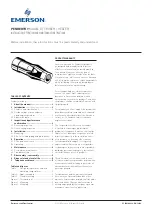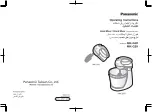
Owner’
s Manual
1
Owner’s Manual
engineer is listening either to the control room [10]
outputs or the phones [11] outputs. The only difference
is that while the listening levels are controlled by the
control room / submix [32] knob, the meters read the
source mix before that control, giving you the real facts
at all times, even if you’re not listening at all.
Thanks to the 802-VLZ3’s wide dynamic range, you can
get a good mix with peaks flashing anywhere between
–20 and +10 dB on the meters. Most amplifiers clip at
about +10 dB, and some recorders aren’t so forgiving ei-
ther. For best real-world results, try to keep your peaks
between “0” and “+6”.
Remember, audio meters are just tools to help assure
you that your levels are “in the ballpark.” You don’t have
to stare at them (unless you want to).
A word about Aux
Sends are outputs, and returns are inputs. The chan-
nel aux [28] knobs taps the signal off each channel. The
sum of the aux signals is sent to the aux master [37]
knob before going to the aux send [15] output.
This output can be fed to the inputs of a reverb or
other device. From there, the outputs of this external
device are fed back to the mixer’s stereo return [8]
jacks, through the stereo return [38] level control, and
finally delivered to the main mix.
So, the original “dry” signals go from the channels to
the main mix, and the affected “wet” signals go from the
stereo return [8] to the main mix. Once mixed together,
the dry and wet signals combine to create a glorious
sound. So, armed with this knowledge, let’s visit the
auxiliary world:
36. PRE or POST (AUX)
Besides being used to work effects into your mix, aux
sends serve another critical role — that of delivering
cue mixes to stage monitors, so musicians can hear
what they’re doing. On the 802-VLZ3, aux send can play
either role, depending on the position of this switch.
With this switch out (disengaged), aux send will tap a
channel pre-fader and pre-mute/alt 3-4, meaning that no
matter how you manipulate those controls as they feed
the main mix, the aux send will continue to belt out that
channel’s signal. This is the preferred method for setting
up stage monitor feeds, as its level is not affected by
changes to the channel's level controls. EQ settings will
affect all aux sends. It's a bit like setting up two PAs,
one at a nice level to keep your band happy, and one at
a nice level to play to your audience. The levels of each
are independent of each other.
With the switch in, the aux send becomes an ordinary
effects send — post-fader (level) and post-mute/alt
3-4. This is a must for effects sends, since you want the
levels of your “wet” signals to follow the level of the
“dry," keeping them at the same ratio. For example, you
do not want a returned echo to stay at one level, when
you turn a channel down; you want it to go down as well.
Post mute/alt 3-4 means that when a channel is muted,
its aux send to an external processor is also muted.
37. AUX MASTER SEND
This knob provides overall level control of aux send,
just before it’s delivered to the aux send [15] output.
This knob goes from off (turned fully down), to unity
gain at the center, with 10 dB of extra gain (turned fully
up). You may never need the additional gain, but here it
is anyway.
This is the knob to turn up when the lead singer
glares at you, points at his stage monitor, and sticks his
thumb up in the air. (If he stuck his thumb down, you’d
turn the knob down, but that never happens.)
38. STEREO RETURN
This control sets the overall level of effects received
from the stereo return [8] inputs. This could be the af-
fected (wet) processed signal returning from an effects
processor, or the stereo signals from another synth or
source. This control is designed to handle a wide range
of signal levels, from off, to unity gain at the center, with
20 dB gain fully clockwise, to compensate for low-level
effects or sources.
Normally, set this knob at the center, and set the ef-
fects device or source's output control to whatever they
call unity gain (check their manual). If that turns out
to be too loud or too quiet, adjust the effects device or
source's outputs, not the mixer. That way, the mixer’s
knobs are easy to relocate at the center.
Signals passing through this control proceed directly
to main mix. The stereo returns do not have mute/alt
3-4 switches, so if you want these signals to get to the alt
3-4 mix, you’ll have to patch the effects device’s outputs
into one of the stereo channels instead of the stereo
return, and mute/alt those channels.
39. POWER LED
This LED will light when the mixer is connected to a
live power supply, and the power switch is turned on.
This lets you know that the mixer's internal circuits are
turned on, and all ready for action.
Turning off the power switch will turn off the mixer
and this LED will go out.
Congratulations! You’ve just read about all the fea-
tures of your 802-VLZ3. You’re probably ready for a cold
one. Go ahead. The rest of the manual can wait.








































